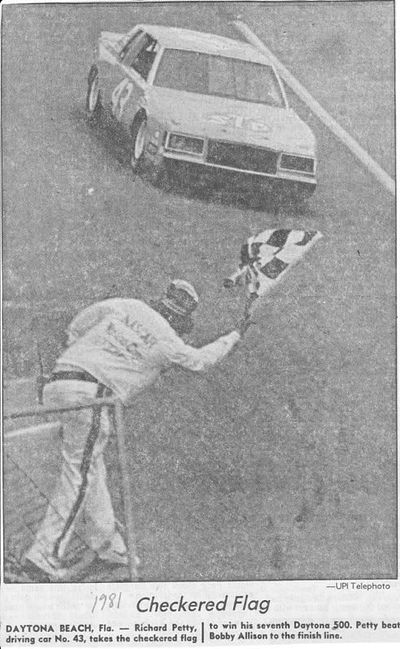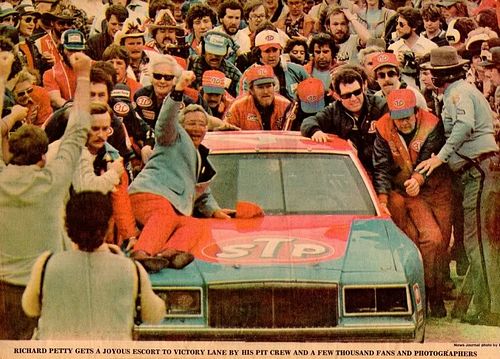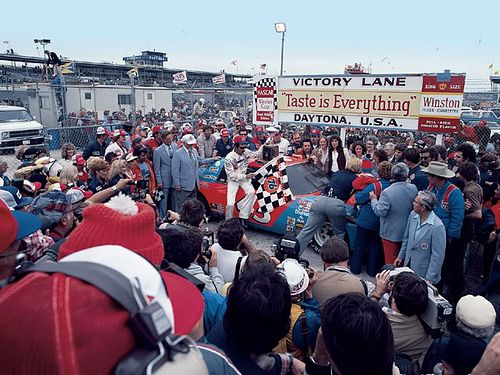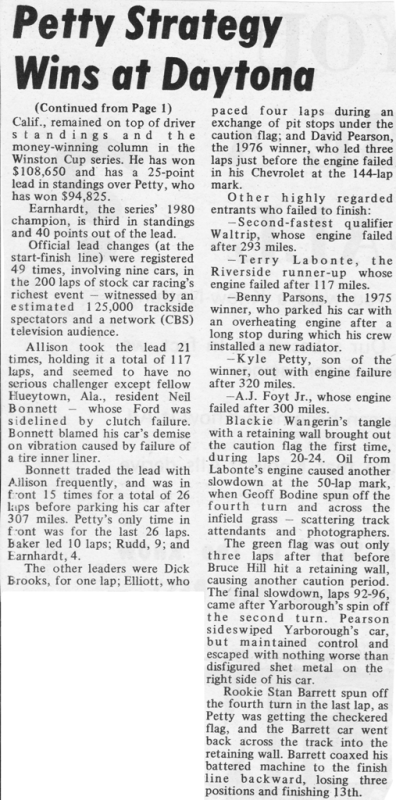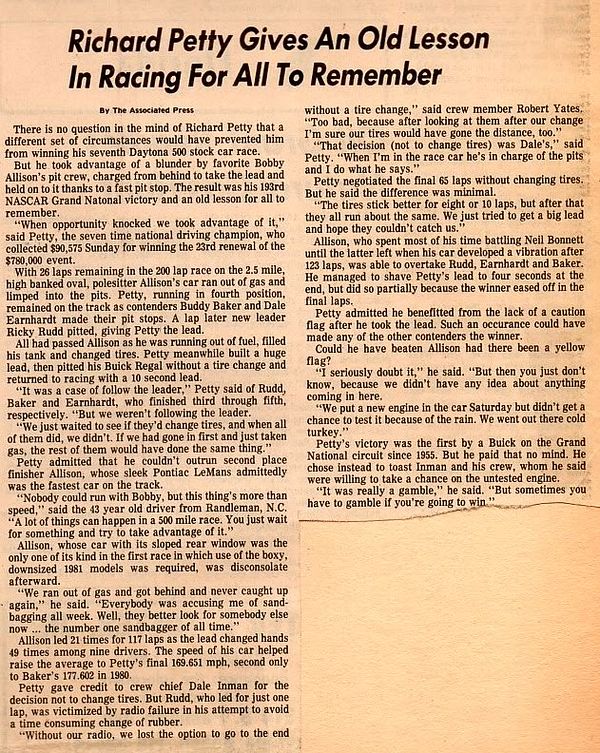This post is dedicated to the memory of Adam Kyler Petty who got to enjoy the celebrations of Victory Lane at Daytona for the first time. ~ TMC
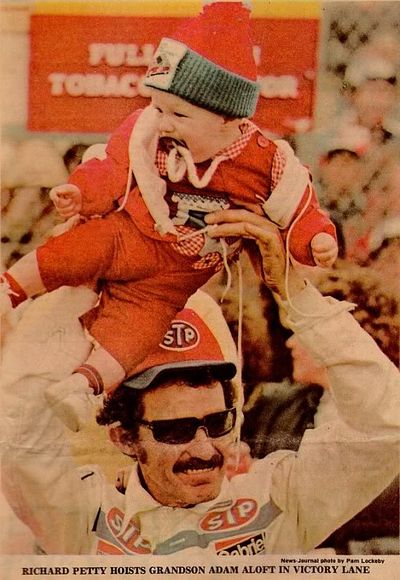
I originally blogged about the 1981 Daytona 500 in 2012 here:
http://bench-racing.blogspot.com/2012/02/february-15-this-day-in-petty-history.html
February 15, 1981 - Driving an STP Buick Regal, Richard Petty wins his seventh and final Daytona 500 for his 193rd career Winston Cup victory.
 Ticket stub scan courtesy of Jerry Bushmire
Ticket stub scan courtesy of Jerry Bushmire
Beginning with the second race of the 1981 season (Daytona), the teams were required to run newer, 110-inch wheelbase cars. The cars more closely matched the models of what the Detroit manufacturers were selling. Gone were the longer, sleeker cars such as the 1977 Chevy Monte Carlo, 1978 Olds Cutlass 442, and 1974 Dodge Charger. Most teams ran models with notch-back windows such as the Buick Regal, Pontiac Grand Prix, a re-designed Monte Carlo, Olds Cutlass, Ford T-Bird and even a Dodge Mirada.
 Source: Motor Racing Programme Covers
Source: Motor Racing Programme Covers
After switching to General Motors' Chevy and Olds cars in 1978 and campaigning them through 1980, Petty Enterprises contemplated a return to Dodge for the 1981 Daytona race. They took a Mirada to January testing. - from RR member and fellow Schaefer HOFer Ron Willard
The team wasn't satisfied with the testing results. When Petty Enterprises returned for Speedweeks a month later, they brought two cars skinned as STP Buick Regals. One was for King Richard... - Jerry Bushmire
... and the other was for son Kyle who was making his first start in the Daytona 500.
The winter tests ginned up several nagging questions for Ron and me - and we hope to get answers one day.
- Was Petty Enterprises prepared to run 2 Miradas for Richard and Kyle if the numbers had been there?
- Would they have fielded a Mirada just for RIchard and a 'throwaway' car for Kyle who had only 1 ARCA and 1 Cup start at Daytona?
- Was PE prepared to switch to Dodge for all of 1981- or just run them at tracks such as Daytona and Talladega?
- Would the Miradas have been painted similar to the Chargers and Magnum vs. the scheme ultimately used on Regal?
After two seasons with Harry Ranier - including a win in the 1980 Daytona 500, Buddy Baker moved to Hoss Ellington's #1 UNO team. Taking his place was veteran Bobby Allison who won the 1978 500 with Bud Moore.
Ranier's Waddell Wilson managed team noted one eligible model that escaped the view of the other teams - a Pontiac LeMans. The car had a slope-back window vs. a notch-back design. With Waddell's HP-heavy engine and a sleeker aero design, the team had a leg up on the competition from the jump.
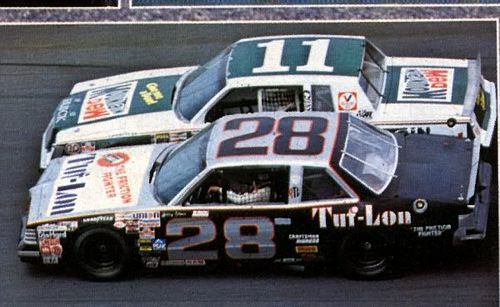
As a result, Allison dominated Speedweeks. He laid down the fastest lap to win the pole for the 500, and led 33 of 50 laps to easily win his 125-mile qualifying race. Darrell Waltrip was also fast in the debut with HIS new team. After extricating himself from a contract with DiGard, he signed with Junior Johnson. The pair qualified 2nd to Allison's top speed, and he called Allison - and raised him - by winning the 2nd qualifying twin AND the 3rd Annual Busch Clash.
The team began the season with some sponsor named Tuf-Lon. I never was quite sure what it was. About a third of the way through the season, Hardee's was secured as a significant backer. The gray ghost paint scheme was then updated to an eye-popping orange and white.- Ray Lamm
In one of the preliminary events, Ohio native Tim Richmond won the ARCA 200. A week later, Richmond made his first Daytona 500 start in D.K. Ulrich's #99 Buick. - Craig Bontrager
Starting 37th in the race, but rallying to finish 6th in his first start at Daytona was second generation driver Davey Allison in one of his dad's venerable, hand-me-down AMC Matadors.
The photographer for the Daytona paper caught a shot that'll bring a lump to your throat. Bobby Dotter Sr tended to his son Bobby Jr. following an accident. Fortunately, neither were significantly injured. - DBMJ
In 1973, Benny Parsons won the Winston Cup championship with L.G. DeWitt's team. Parsons won the Daytona 500 in 1975 with the team. In 1979, rookie and former Petty Enterprises employee Joe Millikan was hired to replace Parsons on the well-established team. But by early 1980, the team's lack of sponsorship essentially killed the team. Rather than return for a strong sophomore year, Millikan found himself bumming for rides and even relief driving for Richard Petty in a few races. He returned to Daytona in February 1981 with Bob Rahilly and Butch Mock's Rahmoc team. But that relationship fizzled within a few races, and Millikan's Cup driving career was essentially over. - TMC archives
Over the years, Daytona's high banks drew many from the open wheel ranks who wanted the challenge their own skills vs. the taxi cab crowd. Wins in the 500 by Foyt and Andretti and in the qualifying race by Johnny Rutherford probably emboldened them all the more. In 1981, Indy regular Tom Sneva attempted to make the show driving for J.D. Stacy. But as drivers such as Dario Franchitti, Robby Gordon, Al Unser Jr, etc. found in the years to come, it ain't as easy as it may look. Sneva failed to finish well enough in his twin to make the 500. - Jerry Bushmire
A new celebrity-laden team made its debut at Daytona's 1981 Speedweeks. Stuntman and Hollywood producer Hal Needham teamed with actor Burt Reynolds and U.S. Tobacco Company to field the Skoal Bandit Pontiac for fellow stuntman turned driver, Stan Barrett. The #22 was chosen because it was the jersey number once worn by Reynolds when he played football for Florida State. The team added a second driver, veteran late model sportsman and 2nd year Cup driver Harry Gant, to its roster in car #33 in the spring. - Jerry Bushmire
Many Cup teams in the years since tried to launch with a celebrity investor / pitchman. Most failed. But Needham's team succeeded where others failed. Barrett didn't last the season but Gant did, and the Skoal Bandit became a Cup fixture for years.
After having about a decade with the previous sized cars, the teams were scrambling to get a handle on the newer models. Almost every one of them was squirelly in the wind with far fewer square inches on the rear deck for downforce and stability. During the first 125 mile twin, John Anderson survived a blowover and barrel roll in his car. A few laps later, Connie Saylor driving for G. C. Spencer had a spectacular view of the dirt as his car went airborne - a phenomenon not seen before at DIS.
The moment was captured and featured on the cover of the May 1981 issue of Stock Car Racing magazine.
Geoff Bodine made his Daytona 500 debut in 1979 driving Jack Beebe's #47 Race Hill Farms Olds. Having missed the 1980 edition, he returned for a second time in 1981 driving a #23 Pontiac for brothers Bob (who later built New Hampshire Speedway) and Dick Bahre (who later formed Bahari Racing with Chuck Rider and driver Michael Waltrip). As he looped the car coming out of turn 4, the spin suddenly took a frightening tone. He skidded through the grass, up an embankment, and down the other side before hitting a local news car. Folks standing nearby suddenly scurried.
John Betts captured this pic as Bodine's car headed up the rise before going down the other side. Incredibly, Bodine's crew was able to get the car back in the race where he finished 22nd.
As it turns out, no one was injured. I think it would have been truly funny - particularly since there were no injuries - if the call letters of the station had instead been WTFV.
Each time I see this pic, I laugh at the guy in the center of the photo. Everyone likely parted like the Red Sea but then returned to gawk at the wrecked car - except this guy. He remained seated on that bumper. I'm wondering as Bodine's car came skidding in there if the guy first said it - and then did it !
In the 500, Allison was the class of the field. As expected, he was a lap bully as he paced the field for 117 laps en route to what looked to be a convincing win. Despite the stunning aeronautical wrecks in the twins, the 500 itself was fairly calm. Aside from Bodine's off road excursion and a last lap wall slapper by Barrett, the cars pretty well held their own during the afternoon.
Kyle Petty's 500 debut was short-lived. He exited after 128 laps with oil pouring oil the bottom of the engine. But his day wasn't done. He took over as a relief driver for Don Sprouse and helped him earn a 20th place finish. Sprouse was making his 5th start of a 6-race Cup career and was driving the #37 car owned by Bob Rogers. Drivers such as Tim Richmond and Mike Alexander would later be hired by Rogers to take the wheel of his #37 team.
On his final pit stop, Allison's 28 team took a full load of fuel and tires . However, when NASCAR Hall of Fame crew chief Dale Inman summoned the 43 to pit road a few laps later, he had a different strategy. Inman called for fuel-only and no tires . In about 7 seconds, the King was headed back to the track with a big lead on Allison because of the pit-time differential.
I still remember Ned Jarrett's call from the pits on TV - and jumping up and down in my folks' living room when I realized what Inman's call meant.
The gap was too much for Allison to overcome, and Inman's heads-up call was rewarded with the King's seventh trip to victory lane in the Daytona 500. No telling how many fist pumps and victory leaps I did in my parents' small house - especially since the victory came against Allison who I now disliked more than Pearson, Cale or DW. I was late to the Petty-Allison rivalry that ran from the late 60s through the early 70s - but I sure tried to make up for lost time.
From TMC Archives
Photo courtesy of Jerry Bushmire
The pivotal pit stops...
The finish, victory lane, and the toll on families...
An eloquent racer's wife and memories of a young Adam...
After 190+ wins and seven championships, Dale Inman [ resigned from Petty Enterprises ] a few days after the win. A couple of weeks later, he announced he was [ going to work for Rod Osterland ] and reigning Winston Cup champion, Dale Earnhardt.
From TMC Archives
Article courtesy of Jerry Bushmire
National Speed Sport News - Russ Thompson
| Fin | Driver | Car |
| 1 | Richard Petty | Buick |
| 2 | Bobby Allison | Pontiac |
| 3 | Ricky Rudd | Oldsmobile |
| 4 | Buddy Baker | Oldsmobile |
| 5 | Dale Earnhardt | Pontiac |
| 6 | Bill Elliott | Ford |
| 7 | Jody Ridley | Ford |
| 8 | Cale Yarborough | Oldsmobile |
| 9 | Joe Millikan | Buick |
| 10 | Johnny Rutherford | Pontiac |
| 11 | Bill Elswick | Oldsmobile |
| 12 | Donnie Allison | Oldsmobile |
| 13 | Stan Barrett | Pontiac |
| 14 | Don Whittington | Oldsmobile |
| 15 | Dave Marcis | Oldsmobile |
| 16 | Dick Brooks | Buick |
| 17 | Tommy Gale | Ford |
| 18 | Ronnie Sanders | Buick |
| 19 | Glenn Jarrett | Buick |
| 20 | Don Sprouse | Oldsmobile |
| 21 | Jimmy Means | Pontiac |
| 22 | Geoffrey Bodine | Pontiac |
| 23 | Harry Gant | Buick |
| 24 | J.D. McDuffie | Pontiac |
| 25 | Elliott Forbes-Robinson | Buick |
| 26 | Buddy Arrington | Dodge |
| 27 | Lennie Pond | Buick |
| 28 | Ronnie Thomas | Pontiac |
| 29 | David Pearson | Chevrolet |
| 30 | Tim Richmond | Buick |
| 31 | Benny Parsons | Ford |
| 32 | Kyle Petty | Buick |
| 33 | Neil Bonnett | Ford |
| 34 | James Hylton | Pontiac |
| 35 | A.J. Foyt | Oldsmobile |
| 36 | Darrell Waltrip | Buick |
| 37 | Cecil Gordon | Buick |
| 38 | Richard Childress | Pontiac |
| 39 | Bruce Hill | Buick |
| 40 | Terry Labonte | Buick |
| 41 | Billie Harvey | Pontiac |
| 42 | Blackie Wangerin | Ford |
--
Schaefer: It's not just for racing anymore.
updated by @tmc-chase: 04/04/17 04:14:54PM















